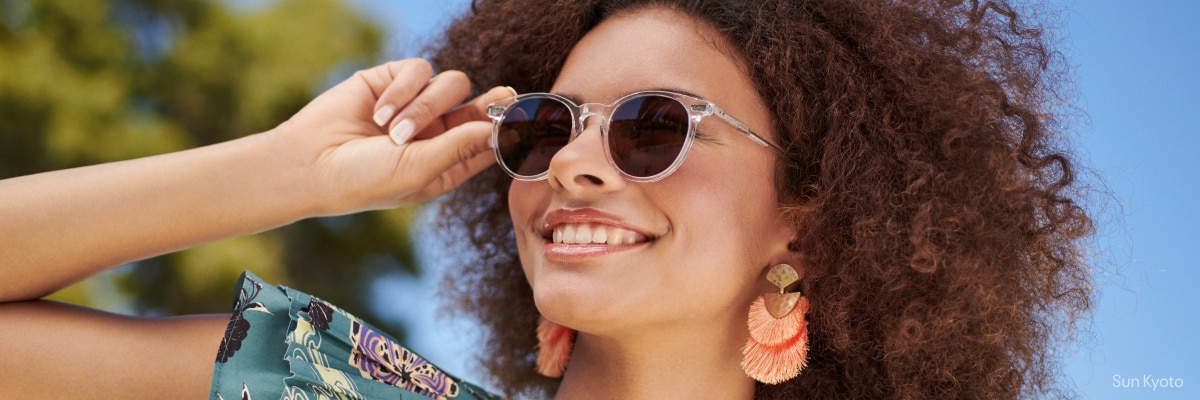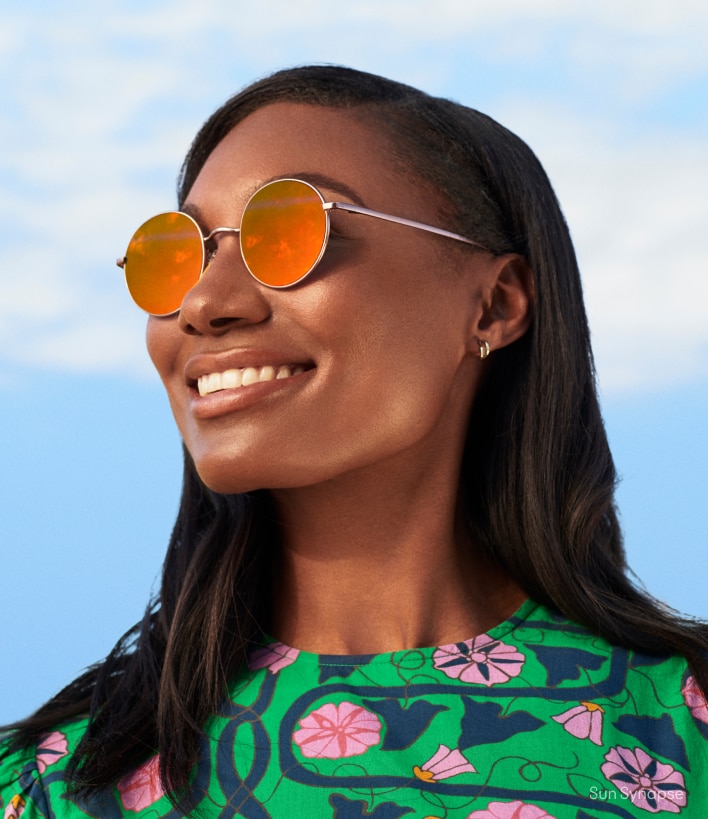In the EBD Blog
Just like frames, sunglass tints come in a variety of options. Some patients pick their lenses simply because they like the color. Others go for a specific tint according to the activity they’re doing, which makes sense because they can help in different ways.
All sunglasses are tinted, but not all are polarized. The benefit of using polarized sunglasses over non-polarized sunglasses is that glare and halos are significantly reduced. This is particularly noticeable during activities such as driving in the rain, or water activities such as fishing. That’s because polarization blocks the light that bounces off of horizontal surfaces.
What Color Polarized Lens is Best?
If you’re primarily wearing them as a fashion statement, then any color can be the ‘best’. But if you’re wearing them for a specific activity, then there are some colors that are better suited.
For computer use, if blue light filtering glasses don’t seem to be enough, you might want to consider rose tinted lenses. They’ve proved to be particularly helpful for people who suffer from migraines.
For indoor or snow sports, you might consider wearing yellow tinted sunglasses. These help to increase contrast in hazy, foggy or low-light conditions. Some people feel they help with night driving, too.
For outdoor precision sports, such as golf, you might want to go for green tinted lenses in your sunnies. They filter some blue light and reduce glare, making it easier to track golf balls.
And what about gradient tints? Which you can also get polarized, by the way. Gradient tints are helpful in situations such as working in changing light conditions. Maybe you’re working in a garden and have to go in and out of a shed for tools. The gradient tint would make it possible where you wouldn’t have to remove your sunglasses to see in the darker areas.
What's the Best Polarized Lens Color for Water Activities?
You might think it’d be blue lenses, since water often appears blue, but you’d be wrong. Most water activities do well with brown or amber tinted polarized sunglasses. These tints help make everything seem more vibrant and brighter, and the polarization makes it possible to see past the reflections coming off the water — important for reeling in your next big catch!
What’s the Best Polarized Lens Color for Driving?
This often comes down to personal preference, but the best lens color options for driving are usually gray or amber. Gray is generally better for bright, hazy, sunny conditions. Amber is often better for cloudy, overcast days and rain. As mentioned above, some people feel yellow helps them with contrast when driving at night, too.
What’s the Best Polarized Lens for Hiking?
Again, this comes down somewhat to personal preference. In general brown or amber lenses are considered best for hiking. But, gray tinted lenses also work well. If you’re hiking in full sun, you might find you prefer gray tints but if you’re hiking through the forest, you’d probably find brown or amber more appealing.
Gray and brown/amber are often good default choices for most outdoor activities and driving, depending on the lighting conditions. You’ll notice this if you check out the sunglasses section of most opticals. Just about every pair of sunglasses will be gray or brown/amber tinted. However, if you participate in any of the activities above, consider giving the other tints a try. Who knows? Maybe it’ll improve your golf handicap the next time you’re on the fairway!
Weather and Environmental Factors
Weather and environment can influence the effectiveness of polarized lenses. In bright conditions, darker lenses like gray or brown can reduce glare and increase comfort. During overcast or foggy conditions, lighter lenses such as yellow or amber enhance visibility by increasing contrast.
Brown lenses are effective in fluctuating weather. They offer clarity in bright sunlight, cloudy skies, and fog, making them ideal for regions with unpredictable weather. Polarized lenses are available in colors like black, blue, and pink. They reduce glare and protect your eyes from harmful UV rays, particularly around water. Consider these factors when selecting a lens color.
Sunglass Lens Color Guide
Sunglass lens colors do more than enhance aesthetics; they can improve visibility. Different lens colors can alter your visual experience by controlling glare and enhancing contrast, making them suitable for various activities and environments.
By understanding different lens colors, you can select sunglasses that complement your style and enhance your vision. Each color offers unique benefits. Let's explore some popular lens colors and their advantages.
Gray Lenses
Gray lenses are effective in various weather conditions. They preserve true color representation without distortion, making them suitable for everyday wear in both sunny and cloudy conditions. They reduce glare without altering colors, which is excellent for driving and outdoor activities.
Brown and Amber Lenses
Brown and amber lenses improve contrast and depth perception. They are particularly beneficial on sunny days and for activities such as hiking or biking. These lenses enhance detail visibility, making them a favorite among outdoor enthusiasts.
Green Lenses
Green lenses offer a balance between gray and brown lenses. They perform well in both low and bright light, maintaining accurate colors while reducing glare, making them a versatile option for many activities.
Yellow Lenses
Yellow lenses provide high contrast in low-light conditions. Popular with sports enthusiasts, such as skiers and shooters, these lenses enhance visibility in fog or overcast skies, ensuring clarity when light is limited.
Blue Lenses
Blue lenses are known for their stylish appeal. In addition to their aesthetic benefits, they reduce glare and maintain color clarity, making them perfect for casual wear and adding a trendy touch to your look.
Understanding the advantages of each lens color can guide you in selecting the best sunglasses for your lifestyle. Whether you're driving, hiking, or simply enjoying the sun, the right lens can enhance both your vision and style.





















